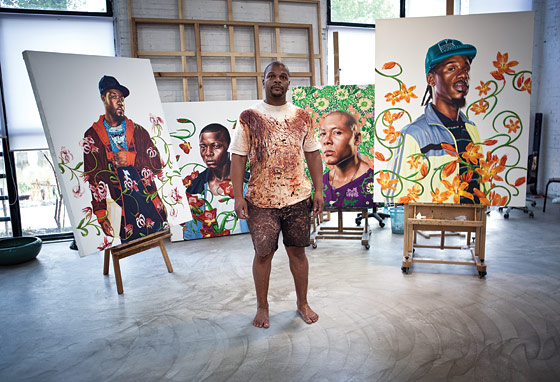 |
Kehinde Wiley in his Beijing studio. (Photo: Matthew Niederhauser/Institute) |
Subtle, I think. Not that Wiley’s work ever seems that subtle at first. Best known for his oversize portraits of young African-American men he finds on the street—“the boys,” he calls them—against florid wallpaperlike backdrops in poses lifted from old portraits of European gentry, Wiley has in a mere decade built a monster career around bright colors, big ideas, and a canvas the size of Earth itself, every person in every nation a potential subject. His series “The World Stage” makes that promise literal, as he globetrots from the favelas of Rio to the slums of Delhi, pulling charismatic-looking men into the studio for Renaissance-style tribute. And his newest portraits, for a show opening May 5 at Sean Kelly Gallery, constitute his first all-female exhibition and tackle no less grand a theme than the historic representation of women in art.
That unabashed bombast has made Wiley a walking superlative: the most successful black artist since Basquiat, possibly the wealthiest painter of his generation, certainly the one who made his name earliest (he was 26 for his first major solo show), a gay man who has become the great painter of machismo for the swag era, a bootstrapper from South Central who talks like a Yale professor (much of the time), a genius self-promoter who’s managed to have it both ways in an art world that loves having its critical cake and eating the spectacle of it, too, and a crossover phenomenon who is at once the hip-hop world’s favorite fine artist (Spike Lee and LL Cool J own pieces) and the gallery world’s most popular hip-hop ambassador. Not to mention an all-around positive guy.
“Women have always been decorative,” Wiley says, gesturing at the portraits around him. ‘They’ve never been actors or possessed real agency.” Compact, with a pink dress shirt tugging at itself across his chest and an unself-conscious gap-toothed grin, he doesn’t look like the grave, hoodie-rocking men he often portrays so much as their nerdy cousin. (He listens to NPR on his Beats headphones.) Despite seeming exhausted, he’s affable and reflective, as if picking up where he left off in some past interview.
Which brings us back to the lady with the severed head. Like most Wiley paintings, this one has a backstory: Her name is Triesha Lowe, Wiley explains. She’s a stay-at-home mom whom Wiley found at the Fulton Mall. Her pose is a riff on classical depictions by Caravaggio and Gentileschi, of the biblical story of Judith beheading Holofernes. And the severed head? “She’s one of my assistants.”
There’s nothing new about artists using assistants—everyone from Michelangelo to Jeff Koons has employed teams of helpers, with varying degrees of irony and pride—but Wiley gets uncomfortable discussing the subject. “I’m sensitive to it,” he says. When I first arrived at his Beijing studio, the assistants had left, and he made me delete the iPhone snapshots I’d taken of the empty space. It’s not that he wants people to believe every brushstroke is his, he says. That they aren’t is public knowledge. It’s just a question of boundaries. “I don’t want you to know every aspect of where my hand starts and ends, or how many layers go underneath the skin, or how I got that glow to happen,” he says. “It’s the secret sauce! Get out of my kitchen!”
Producing work in China cuts costs, but not as much as it used to, Wiley says. These days in Beijing he employs anywhere from four to ten workers, depending on the urgency, plus a studio manager, the American artist Ain Cocke. The Beijing studio began as a lark: After visiting an artist friend there and liking what he saw, he and a couple of his New York staffers flew out, rented some space, and started painting, “sort of like a retreat,” he says. One thing led to another—“another” being a five-year relationship with a Chinese D.J.—and eventually the Beijing studio became the main production hub as well as his second home. He recently bought an apartment overlooking Chaoyang Park, complete with a live-in maid and two miniature greyhounds, Xiaohui, or “Little Gray,” and Celie, named after the character in The Color Purple.


No comments:
Post a Comment